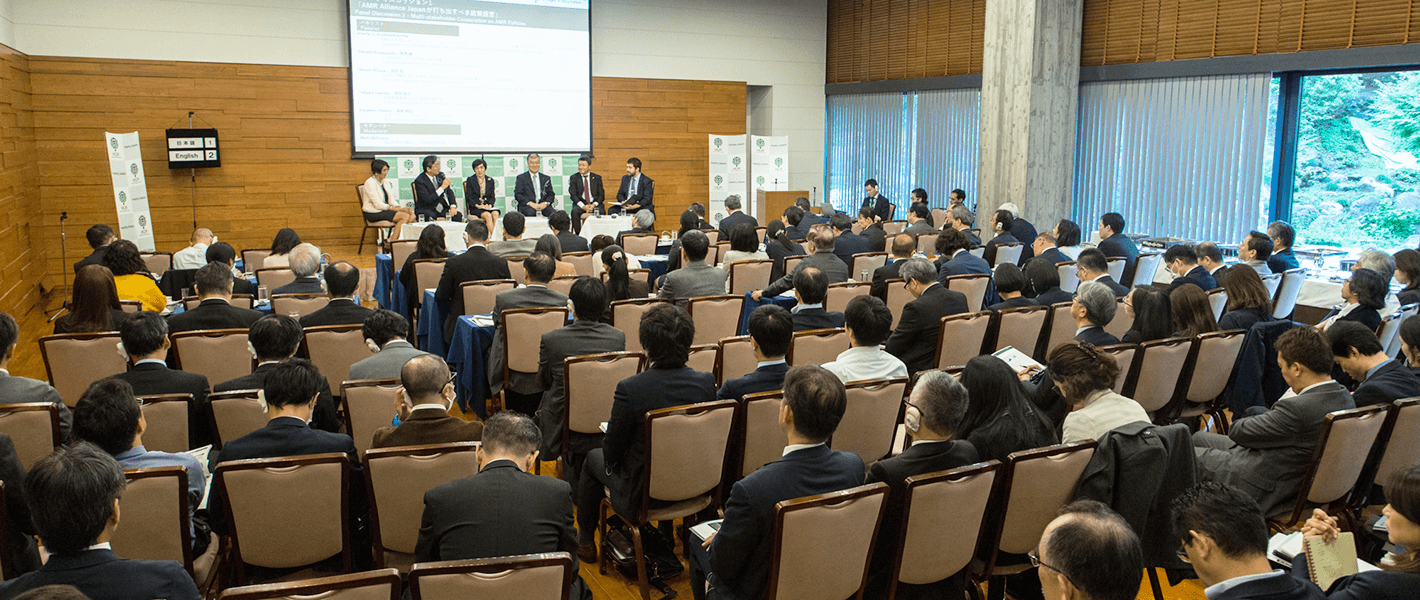[Lived Experiences] AMR Control in Conflict Zones: Challenges and New Perspectives on AMR Control in Conflict Zones as Seen in Medical Practice in the Gaza Strip (June 10, 2025)
- Home >
- Information >
- News >
- [Lived Experiences] AMR Control in Conflict Zones: Challenges and New Perspectives on AMR Control in Conflict Zones as Seen in Medical Practice in the Gaza Strip (June 10, 2025)
Dr. Tatsuya Ukawa
Physician, Médecins Sans Frontières
Antimicrobial Resistance (AMR) is a phenomenon in which the use of antimicrobials causes bacteria (or pathogens) to mutate in ways that make antimicrobials less effective. To address AMR, which is known as one of the greatest threats to human health, Japan and other developed countries are introducing countermeasures that are based on efforts like practicing basic hygiene, preventing hospital-acquired infections, and establishing advanced health facilities. However, in conflict zones, the collapse of health systems makes it extremely difficult to implement AMR countermeasures. Because life-saving treatments must be prioritized in conflict zones, this tends to result in infectious disease control becoming deprioritized, and that includes measures for AMR. As a result of this change in priorities, AMR can cause treatment options to become limited. Furthermore, AMR bacteria can spread across national borders, so it is vital that the global community work to prevent such spread. Given the possibility of international outbreaks, in the current age of globalization, conditions surrounding AMR control overseas is a key item to which we in Japan must pay close attention.
 AMR Alliance Japan (Secretariat: Health and Global Policy Institute (HGPI)) has been working closely with people impacted by antimicrobial resistance (AMR) in Japan and abroad, with the aim of advancing policies to combat AMR. As part of this effort, starting in 2021, AMR Alliance Japan has been gathering lived experience related to AMR. In this article, in order to grasp real-world circumstances surrounding AMR issues in conflict zones, we interviewed Dr. Tatsuya Ukawa, a member of Médecins Sans Frontières (MSF) who participated in humanitarian medical care in the Gaza Strip for seven months from April 2023. While MSF and a number of other international humanitarian medical organizations are actively providing care in Gaza, it is apparent that various challenges related to AMR are present in the region.
AMR Alliance Japan (Secretariat: Health and Global Policy Institute (HGPI)) has been working closely with people impacted by antimicrobial resistance (AMR) in Japan and abroad, with the aim of advancing policies to combat AMR. As part of this effort, starting in 2021, AMR Alliance Japan has been gathering lived experience related to AMR. In this article, in order to grasp real-world circumstances surrounding AMR issues in conflict zones, we interviewed Dr. Tatsuya Ukawa, a member of Médecins Sans Frontières (MSF) who participated in humanitarian medical care in the Gaza Strip for seven months from April 2023. While MSF and a number of other international humanitarian medical organizations are actively providing care in Gaza, it is apparent that various challenges related to AMR are present in the region.
(Dr. Ukawa answering questions during the interview)
Contents:
The role of infectious disease specialists in connecting clinicians and medical technologists
Challenges for perioperative management in conflict zones
The pros and cons of antimicrobials being readily obtainable
Cultural concerns and infection control
The role of infectious disease specialists in connecting clinicians and medical technologists
In conflict zones, infectious disease specialists play a key role in managing infectious diseases by connecting clinicians and medical technologists. During my activities in the Gaza Strip, I served as an antibiotic doctor in a limb reconstruction project. The nature of conflict zones means that surgical treatments for trauma injuries caused by gunshots or bombings must be performed frequently, and such situations require proper infection management. To that end, I worked with medical technologists to evaluate the validity of test results and with surgeons, internists, and other clinicians to provide support in selecting and using optimal antibiotics. However, it can be difficult for medical technologists to keep track of medical status on site, and clinicians often do not know the details of laboratory operations, so specialists are needed to connect those parties. Just as communication among clinicians and medical technologists in real-world healthcare settings can be limited even in Japan, building a foundation for collaboration in conflict zones is vital.
In MSF projects, specialists called “reference managers” take part in laboratory operations from the time they are set up, and their role is to serve as a link between laboratories and clinics. Reference managers are well-versed in global standards for testing methods and support antimicrobial stewardship when medical resources are limited. When conflicts escalate and clinical medical technologists and other professionals can no longer attend the laboratory, laboratory operations become even more difficult. When that happened, I was able to select antimicrobials or determine treatment plans using data we had already accumulated. Those experiences reminded me of the importance of making preparations for infectious disease control during peacetime.
Challenges for perioperative management in conflict zones
Four to five surgical procedures were performed per day at the facility, and at any given time, the ward housed around 20 perioperative patients. One of the greatest challenges in such an environment is perioperative infection management. In conflict zones, there are major shortages in the medical resources needed for proper perioperative management, especially for infection control. For example, bacteriological testing is an essential part of proper perioperative management, but shortages of the reagents needed to perform that testing make it difficult to accurately identify infectious pathogens.
Another serious problem is the lack of testing equipment. At health institutions in Japan, susceptibility tests (which determine if a certain antimicrobial is effective against a certain bacteria) are generally performed using an automated method called broth microdilution. In Gaza, such testing equipment is almost non-existent, so I sometimes had to perform testing manually using a method called the disk diffusion test. That method is time-consuming and labor-intensive, and results are sometimes less accurate than the automated method.
This made it difficult to identify infectious pathogens and select suitable antimicrobials, resulting in more postoperative infections. There were many cases of conditions which are rarely seen in Japan, such as postoperative osteomyelitis. When patients have particularly severe trauma such as from a gunshot wound and have already used antimicrobials multiple times, antimicrobial options become limited. In some cases, I had no choice but to select antimicrobials that are not commonly used in Japan.
While such an environment is harsh, Gaza’s health facilities have clinical medical technologists, and the local staff are highly motivated to learn. While there are a number of challenges—such as the difficulty of grasping patients’ treatment histories due to the fact that it is still the norm to manage medical records using paper records—with support from MSF, they are proactive about adopting new testing methods and other practices, and seeing their forward-looking attitudes gives me hope.
The pros and cons of antimicrobials being readily obtainable
Turning our attention from health facilities to the situation in urban areas, in conflict zones and low- and middle-income countries, many pharmacies sell antimicrobials without a prescription. In the context of AMR control, this is a serious problem. A lack of antimicrobial stewardship is accelerating the development of AMR bacteria and is decreasing treatment options. Antimicrobial stewardship is essential for AMR control, but it is clear that this environment is facilitating the development of AMR.
To help prevent inappropriate antimicrobial sales , I held study sessions for local pharmacists about once a week. However, I feel there are limitations as to what can be achieved through efforts from local pharmacists alone. Addressing this issue will require more comprehensive initiatives such as educating citizens or reforming local systems to regulate pharmaceutical sales. On the other hand, severely restricting antimicrobial sales has the potential to be a matter of life or death for citizens who live in conflict zones or in low- and middle-income countries and have limited access to appropriate treatments, so I think measures must be taken carefully.
Cultural concerns and infection control
In some conflict zones, primarily in Muslim countries, there are cultural or religious factors that require consideration when determining treatment plans, such as for the use of medicines during Ramadan. For example, compared to other pharmaceuticals, many antimicrobials place a greater burden on the kidneys (known as nephrotoxicity), so antimicrobial administration requires careful planning during Ramadan, when water intake is restricted. Together with local staff, we took dehydration risk and reduced kidney function into account when arranging dosing schedules. I think having an attitude that respects the cultural backgrounds of others is essential in promoting and enhancing measures for AMR control.
In conclusion: Thinking about AMR control in conflict zones is the same as thinking about the shape of sustainable healthcare
An important part of AMR control is establishing medical and laboratory systems to expand infectious disease care. Ensuring proper AMR measures are implemented even in conflict zones will require both human and material support. This means not only having a supply of testing equipment and therapeutics, but also assigning infectious disease specialists who can link clinical medical technologists and clinicians. Another key effort in Gaza was to encourage antimicrobial stewardship by engaging pharmacists in AMR control and providing opportunities to raise awareness and educate local residents.
In fact, many of these challenges are not only present in conflict zones; they are also common in developed countries, including Japan. Modern AMR control measures may present a new challenge that asks how citizens living in each country and region can ensure healthcare sustainability through the innovation we developed 100 years ago known as antimicrobials.
■ Case studies from various experts related to AMR
Case study 01
Dr. Keiji Okinaka(Director of Infection Control and Prevention Section, National Cancer Center Hospital East / Department of General Internal Medicine, National Cancer Center Hospital East /Division of Hematopoietic Stem Cell Transplantation, National Cancer Center Hospital)
“A disseminated filamentous fungal infection that broke through echinocandin antifungal treatment”
Case study 02
Dr. Shogo Otake and Dr. Masashi Kasai (Department of Infectious Diseases, Hyogo Prefectural Kobe Children’s Hospital)
“AMR can affect newborns! A 5-month-old boy with a urinary tract infection caused by AMR bacteria”
Case study 03
Dr. Takashi Ueda (Department of Infection Control and Prevention, Hyogo College of Medicine Hospital)
“Candidemia Requires Routine Ophthalmologic Evaluation!”
Case study 04
Dr. Akari Shigemi(Division of Pharmacy / Department of Infection Control and Prevention, Kagoshima University Hospital)
“The importance of proper antimicrobial use for MRSA infections – Beware of rifampicin monotherapy induced resistance”
Case study 05
Dr. Keisuke Kagami (Department of Pharmacy, Hokkaido University Hospital)
Dr. Mitsuru Sugawara (Department of Pharmacy, Hokkaido University Hospital / Laboratory of Pharmacokinetics, Faculty of Pharmaceutical Sciences, Hokkaido University)
“Concomitant piperacillin-tazobactam and vancomycin use increases the risk of acute kidney injury.”
Case study 06
Dr. Keisuke Kagami (Department of Pharmacy, Hokkaido University Hospital)
Dr. Mitsuru Sugawara (Department of Pharmacy, Hokkaido University Hospital / Laboratory of Pharmacokinetics, Faculty of Pharmaceutical Sciences, Hokkaido University)
“Thrombocytopenia Can be Avoided By Monitoring Linezolid Blood Levels – Enabling Long-Term Linezolid Use for the Successful Treatment of Refractory Pyogenic Spondylodiscitis.”
Case study 07 – Lived Experiences
Ms. Sachiko Ito (Supporter, AMR Alliance Japan / Person Affected by Non-tuberculous Mycobacterial (NTM) Lung Disease)
“I hope more healthcare professionals take an interest in Antimicrobial Resistance (AMR) and work to promote the appropriate usage of antimicrobials.”
Case study 08
Dr. Koji Masuda (Vice Chief Pharmacist, Department of Pharmacy, International Healthcare and welfare University, NARITA Hospital)
Dr. Kenji Ikeda (Chief Pharmacist, International Healthcare and welfare University, NARITA Hospital / Deputy Director, Department of Pharmacy, Narita Hospital, International University of Health and Welfare)
“TDM Is Not Only for Safety, but for Ensuring Effectiveness.”
Case study 09 – Lived Experiences
Mr. Junichi Maruyama (Former Ambassador of Japan to Serbia)
“Experiences with Eye Disease and AMR”


